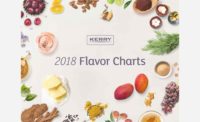Kerry: Flavor Forecast
Kerry expert links trends with new tastes for 2024

Soumya Nair, global consumer research and insights director, Kerry
PHOTO COURTESY OF: Kerry

PHOTO COURTESY OF: Kerry

PHOTO COURTESY OF: Kerry



Editor’s note: Following is a supplied interview featuring Soumya Nair, Global Consumer Research and Insights Director at Kerry, Beloit, Wis. Below, Nair identifies five key trends and links them to related tastes and flavors for formulators to consider.
Q: What do you foresee as the biggest flavor trends coming to the forefront in 2024?
Soumya Nair: Flavor trends are deeply rooted in the changing consumer priorities and in the coming year consumers’ priority in wanting conscious, empowered and comforting foods will gain significance.
• Empowering Eats: People want to be heard and feel seen in the food and beverages made available to them. Whether it’s low to no alcohol or vegan or plant-based etc., consumers want to feel empowered to decide their personal priorities and have solutions that support their decision.
We expect to see grain-free pasta and meals, alternative dairy ingredients. Interestingly, cashew is enjoying its limelight in soft cheese, spreads and dips. Also look for more zero-proof drinks and cocktails that give them the social belonging without the need to change their low-no alcohol goals.
• Authentic Adjacent: Food tourism has returned over the past couple of years as consumers broke free of their pandemic restrictions. This meant consumers got back their thirst for adventure and authentic experiences. Social media has further catalyzed this consumer nerve. But in the recent months and into 2024, authentic foods will take on a new dimension with chefs and baristas inspiring a brave twist on authentic foods.
“Heritage Remix” is unabashed, bold and tells a story and creates an intercultural collaboration (also closely linked with the trend of empowering eats) Think beyond fusion foods and third culture cuisine to different cultures bravely inspiring each other –
We will see tikka sauce wings and za’atar wings, birria ramen, sashimi tostadas, tandoori masala pasta, wasabi/kimchi mashed potatoes, cheeseburger ravioli, and Vietnamese po-boys. These uncharacteristic combinations are rising, and consumers are here for it.
• Thrilling Comfort: Comfort has always been and will always be a foremost driver of flavors in foods. In recent months we noticed an uptick of comfort flavors with a flair for spice and heat. In the US along, spicy LTOs have grown significantly and now 71% of US menus carry spicy as a menu call out. [LTO – limited time offer]
We expect to see spicy everything—from spicy honey, spicy cocktails and sparkling waters, spicy chocolates and candies and sauces. We also will see interesting new spice ingredients including arbol peppers, gochugaru, tajin seasoning. There also will be new variants of the fried chili sauces appearing across the world – e.g., salsa macha (the cousin of the fried chili sauce), and sambal oelek continues.
Comfort sauces and bold flavors with new origins will continue as well. Examples include garlic inspired Lebanese toum, Provençal pistou, chaat masala, tamarind, etc.
Meanwhile we will continue to see more comfort nostalgic flavors and blurring of these flavors such as alcoholic flavors inspiring sweet and savory foods, dessert-inspired flavors in beverages and meals, etc.
• Renaissance Revival: Heirloom food and ingredients are experiencing a revival as consumers want to taste and experience history.
Here, flavors and ingredients we will see include Middle Eastern anise-flavored arak liquor, cave-aged and pottery-cooked foods such as cheese, meats, breads, retro soda and retro shakes, depression-era slugburgers, and flavors that pay homage to the golden ages.
• Near Nature: Personal home gardens and foraging have become dominant behaviors adopted by consumers worldwide, significantly more after the pandemic. This has resulted in a closer relationship with ingredients—all around how to grow, how to preserve and how to cook with these ingredients. Moreover, this trend is no longer just limited to the summer months.
Here, we flavors and ingredients we expect include cider, pickles, brine, vinegars and fermented foods. All of these are rising in consumer searches, in products, recipes, and on the menu. Also giving rise to new botanicals, spices and herbs such as nettle, and mushrooms of all kinds for texture, flavor and function.
• Conscious Consumerism: The “& consumer” stays strong. They prioritize taste alongside nutrition, healthy aging, and sustainability and their impact on the society, community, and environment. This means the need for craveable flavors will sit alongside the need for ingredient transparency, functional health ingredients, and sustainable solutions. Consumers face a world of contradictions with critical uncertainties of food waste, food scarcity, and the reality of supply challenges and geopolitics affecting their foods.
In regard to flavors and ingredients, we expect to see BCAA, creatine, functional mushrooms, berberine and electrolytes.
At the same time consumers are moving toward frugal foods and practices hoping to guard themselves against the rising cost-of-living crisis and fear of inflation and recession. Zero-stigma foods are coming back. This includes tinned fish, bath cooking, and “instant” everything.
Looking for a reprint of this article?
From high-res PDFs to custom plaques, order your copy today!








